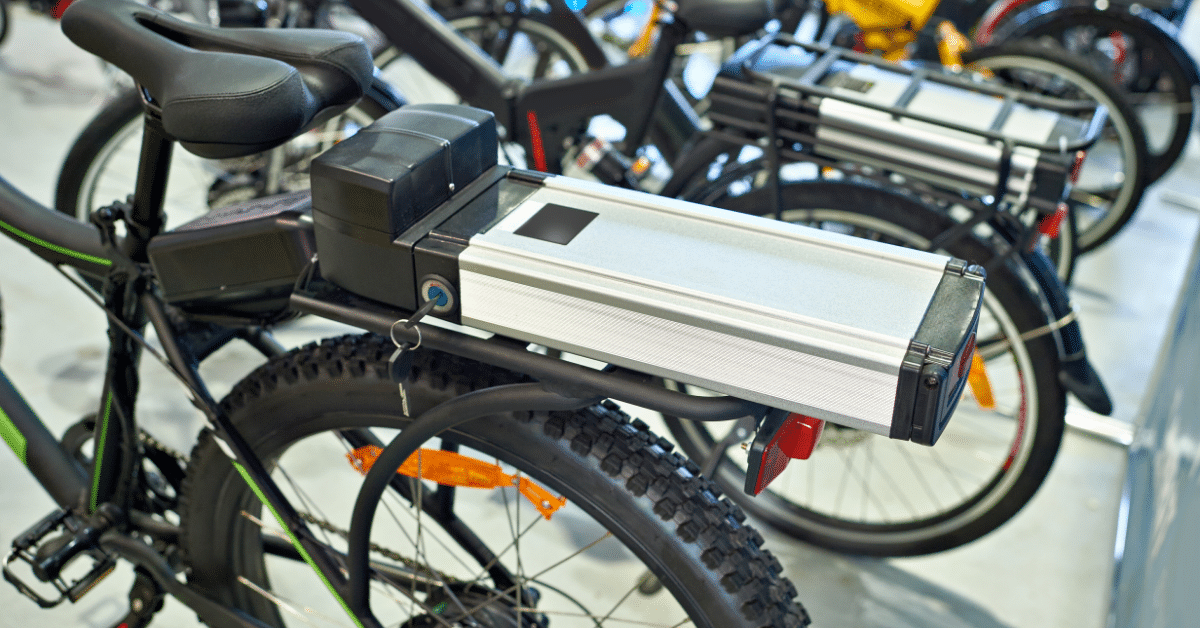Electric bike battery storage requires a cool, dry environment. Avoid extreme temperatures and keep the battery partially charged.
Proper storage of electric bike batteries ensures longevity and performance. Maintaining a cool and dry environment prevents damage from moisture and heat. Avoiding extreme temperatures, both high and low, is crucial. Keeping the battery partially charged, ideally between 30% and 80%, helps maintain battery health.
Regularly checking and recharging the battery every few months can prevent deep discharge. Storing the battery in a clean, dry place away from direct sunlight is advisable. These practices help in maintaining the battery's optimal performance and extending its lifespan. Proper storage not only enhances the battery's efficiency but also ensures a safer and more reliable ride.
Choosing The Right Battery
Selecting the right battery is essential for your electric bike's performance. The battery affects your bike's range, speed, and overall efficiency.
Understanding the different types of batteries and their capacities will help you make an informed decision.
Types Of Batteries
Electric bike batteries come in various types. Each type has its own benefits and drawbacks.
- Lithium-ion (Li-ion): Lightweight and durable. Most common in modern e-bikes.
- Lithium Polymer (LiPo): Flexible shapes, high energy density, and better efficiency.
- Nickel-Metal Hydride (NiMH): Better than older nickel-cadmium batteries. Less common today.
- Lead-Acid: Heavy and bulky. Least efficient, mostly outdated.
Battery Capacity
Battery capacity is crucial for determining how far you can travel on a single charge.
| Battery Type | Average Capacity (Wh) | Range (Miles) |
|---|---|---|
| Lithium-ion | 300-500 Wh | 20-50 miles |
| Lithium Polymer | 400-700 Wh | 30-60 miles |
| Nickel-Metal Hydride | 200-300 Wh | 10-20 miles |
| Lead-Acid | 100-150 Wh | 5-10 miles |
Higher capacity batteries provide longer range but are heavier and more expensive. Choose a battery that balances your needs and budget.

Credit: ebike-mtb.com
Proper Charging Practices
Electric bike batteries are vital for smooth rides. Proper charging practices extend battery life and ensure safety. Follow these tips to keep your battery in top shape.
Charging Frequency
Charge your electric bike battery regularly. Frequent charging helps maintain battery health. Avoid letting the battery drop below 20% charge. Keeping the battery between 20% and 80% is ideal.
- Charge after every ride, if possible.
- Avoid full discharges to prolong battery life.
Avoid Overcharging
Overcharging can damage the battery. Always unplug the charger when the battery is full. Use a charger with an automatic shut-off feature. This prevents overcharging and ensures safety.
- Check the battery indicator regularly.
- Store the battery at around 50% charge if unused for long periods.
Follow these simple practices to keep your electric bike battery healthy and efficient.
Temperature Considerations
Temperature Considerations are crucial for maintaining the lifespan and performance of electric bike batteries. Understanding how temperature affects your battery can help you store it properly and ensure it lasts longer.
Ideal Storage Temperatures
Storing your electric bike battery at the right temperature can greatly impact its longevity. The ideal temperature range for battery storage is between 10°C (50°F) and 25°C (77°F).
In this range, the battery remains stable and maintains its charge effectively. If the temperature is too high or too low, it can cause permanent damage to the battery cells.
| Temperature Range | Effect on Battery |
|---|---|
| Below 0°C (32°F) | Reduced capacity, risk of freezing |
| 10°C (50°F) - 25°C (77°F) | Optimal performance and longevity |
| Above 30°C (86°F) | Overheating, reduced lifespan |
Effects Of Extreme Temperatures
Extreme temperatures can have a serious impact on your electric bike battery.
High temperatures can cause the battery to overheat. This may result in swelling or even explosions. On the other hand, low temperatures can reduce the battery's capacity and efficiency.
- High Heat: Speeds up chemical reactions, leading to faster degradation.
- Freezing Conditions: Slows down chemical reactions, causing reduced capacity.
If you live in an area with extreme temperatures, consider storing your battery indoors. This will help to maintain an optimal temperature.

Credit: nbda.com
Battery Maintenance Tips
Proper care for your electric bike battery ensures a longer lifespan. Follow these simple tips to keep your battery in top condition. Regular inspections and cleaning contacts are essential tasks.
Regular Inspections
Check your battery for any signs of damage. Look for cracks or bulges. Inspect the battery casing and terminals. Ensure there are no leaks or corrosion. Use a soft cloth to wipe off dust. Regular inspections help detect issues early. This prevents bigger problems later.
Cleaning Contacts
Clean battery contacts to ensure a good connection. Dirty contacts can reduce efficiency. Use a dry cloth to wipe contacts clean. Avoid using water or chemicals. For stubborn dirt, use a soft brush. Ensure the contacts are completely dry before use.
| Task | Frequency |
|---|---|
| Inspect battery | Weekly |
| Clean contacts | Monthly |
- Inspect for damage or leaks weekly.
- Clean battery contacts monthly.
- Use a soft cloth and brush for cleaning.
Storage Solutions
Electric bike batteries require proper storage to ensure their longevity and efficiency. Choosing the right storage solution is crucial for maintaining battery health. Below, we explore various storage options to help you make an informed decision.
Indoor Vs. Outdoor Storage
Indoor storage is often the best choice for electric bike batteries. Storing batteries indoors protects them from weather conditions. It also keeps them away from temperature extremes. A cool, dry place is ideal.
Outdoor storage can be convenient but comes with risks. Weather changes can affect battery performance. Extreme heat or cold can damage the battery. If you must store outdoors, use a weather-proof case.
| Storage Type | Pros | Cons |
|---|---|---|
| Indoor Storage |
|
|
| Outdoor Storage |
|
|
Portable Storage Options
Portable storage options offer flexibility and convenience. These options allow you to carry your battery with ease.
Battery bags are designed for easy transport. They are padded and insulated to protect the battery. Some bags also offer extra storage for tools and accessories.
Hard cases provide additional protection. They are often waterproof and shock-resistant. These cases are ideal for long-term storage or travel.
- Choose a padded battery bag for daily use.
- Opt for a hard case for added protection.
Proper storage solutions can extend your battery's life. Choose wisely to keep your electric bike running smoothly.
Extending Battery Life
Electric bike batteries are expensive. Extending their life can save you money. Learning good habits can make your battery last longer. Here, we share useful tips.
Optimizing Riding Habits
Your riding habits affect battery life. Follow these tips for better battery health:
- Avoid sudden acceleration. Start slowly.
- Maintain a steady speed. Fast stops use more power.
- Use lower assist levels. Save high levels for hills.
- Charge your battery regularly. Do not wait until it's empty.
Using Battery Management Systems
Battery Management Systems (BMS) help keep your battery healthy. They monitor and control battery functions. Here are ways BMS can help:
| Function | Benefit |
|---|---|
| Overcharge Protection | Prevents damage from too much charging. |
| Temperature Control | Keeps battery at safe temperatures. |
| Discharge Protection | Stops battery from draining completely. |
A good BMS is like a guardian for your battery. It ensures everything runs smoothly.
Safety Precautions
Electric bike batteries need careful handling and storage. Following safety precautions helps prevent accidents and prolongs battery life. Here are key safety measures to keep in mind.
Handling Damaged Batteries
Damaged batteries pose serious risks. Always inspect your battery for damage. Look for signs such as bulging, leaking, or unusual smell.
- Do not use a damaged battery. It may catch fire or explode.
- Wear gloves and safety glasses when handling damaged batteries.
- Dispose of damaged batteries properly. Contact local disposal services.
- Avoid exposing damaged batteries to heat or moisture.
Preventing Short Circuits
Short circuits can cause fires. Proper storage and handling prevent such incidents.
- Store batteries in a cool, dry place. Keep them away from metal objects.
- Use battery cases or covers. This prevents accidental contact with metal.
- Never stack batteries on top of each other without separators.
- Check connections regularly. Ensure terminals are clean and secure.
| Safety Tip | Reason |
|---|---|
| Avoid extreme temperatures | Protects battery life and safety |
| Inspect regularly | Detects early signs of damage |

Credit: www.amazon.com
Future Trends In Battery Technology
Electric bike batteries are evolving rapidly. Future trends show exciting developments. These advancements promise better performance and convenience. Let's explore some key trends in battery technology.
Advancements In Battery Materials
New battery materials are emerging. These materials offer better efficiency and longer life. Solid-state batteries are one example. They use solid electrolytes instead of liquid ones. This makes them safer and more stable.
Graphene batteries are another innovation. Graphene is a form of carbon. It is light and strong. Graphene batteries charge faster and last longer. These advancements improve the overall experience of electric bike users.
Innovations In Charging Methods
Charging methods are also improving. Wireless charging is becoming popular. It allows you to charge your bike without plugs or cables. Just park your bike on a charging pad.
Fast charging technology is another exciting trend. It can charge your bike in minutes instead of hours. This makes electric bikes more convenient for daily use.
Here is a comparison table of traditional and new charging methods:
| Charging Method | Time Taken | Convenience |
|---|---|---|
| Traditional Plug-in | 4-6 hours | Moderate |
| Wireless Charging | 3-5 hours | High |
| Fast Charging | 30-60 minutes | Very High |
These trends in battery technology make electric bikes more efficient and user-friendly. They open up new possibilities for daily commuting and adventure rides.
Frequently Asked Questions
How To Store An Electric Bike Battery?
Store your electric bike battery in a cool, dry place. Avoid extreme temperatures. Keep it between 50-77°F (10-25°C). Charge it to around 50% if storing long-term.
Can I Leave My E-bike Battery On The Bike?
It's not recommended to leave the battery on the bike. Remove it to prevent theft and damage. Store it in a safe place.
How Often Should I Charge My E-bike Battery?
Charge your e-bike battery after each ride. Avoid letting it fully discharge. Keeping it charged extends battery life.
What Temperature Is Best For E-bike Battery Storage?
Store your e-bike battery at temperatures between 50-77°F (10-25°C). Extreme cold or heat can damage the battery.
Conclusion
Proper electric bike battery storage ensures longevity and peak performance. Follow these tips for safe and effective storage. Protect your investment by avoiding extreme temperatures and ensuring regular maintenance. With these practices, you'll enjoy many more miles on your electric bike.
Happy riding!

No comments:
Post a Comment